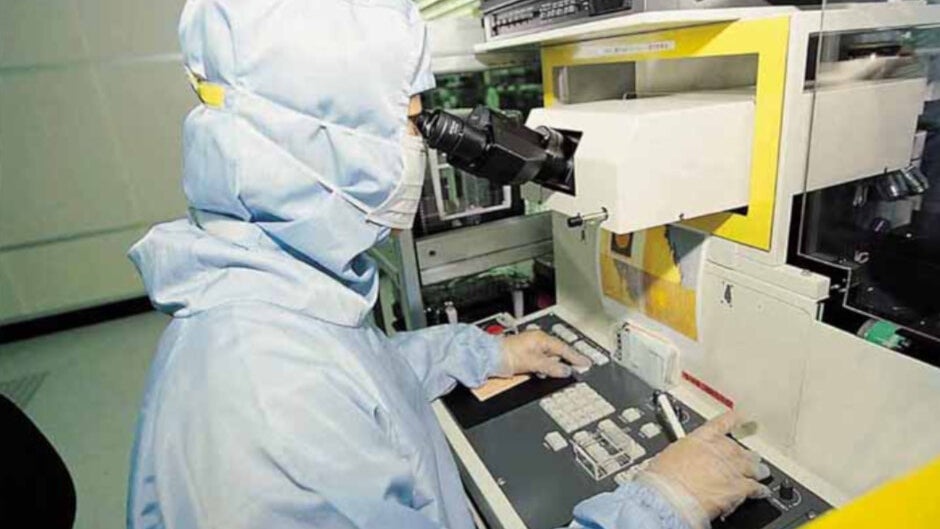Material being tested could lead to more powerful phones with longer battery life

It is the biggest question in the electronics industry today. How can the chip industry continue Moore's law? The latter is the observation made by Intel co-founder and former CEO Gordon Moore that the number of transistors in a dense integrated circuit doubles every other year. The original observation, made in the mid 60s, originally called for the number of transistors to double every year. The "Law" is important because the higher the transistor density of a chip (number of transistors that fit in a square mm), the more powerful and energy efficient a chip is.
Research team discovers new material that might keep Moore's Law alive
Here's an example. The Apple A13 Bionic chipset was manufactured in 2019 by TSMC using the foundry's 7nm process node. With a transistor density of nearly 90 million per square mm, the A13 Bionic, powering the iPhone 11 series, contained 8.5 billion transistors. The A14 Bionic was made in 2020 by TSMC using its 5nm process node. This chip packs 134 million transistors into a square mm delivering a transistor count of 11.8 billion transistors. Next Year, TSMC is expected to start churning out 3nm integrated circuits and both it and Samsung have road maps taking production down to 2nm.

Apple's A14 Bionic chipset was the first 5nm chip ever used on a commercially available smartphone
But what will happen after 2nm and beyond? Many analysts say that Moore's Law is dead even though that pronouncement has been made before and new technology paved the way for its continuation. In a report published by Nature Materials (via Phys.org), researchers say that they are looking at a new class of material that will be able to keep chips cool even while they become smaller in size. Managing the heat created by putting more circuits on a smaller chip is one of the problems that chip designers and manufacturers face. This is a major problem because not only are the number of circuits getting larger, the size of the chip is getting smaller and the transistors are getting closer to each other. That makes it harder to draw the heat away to prevent circuits from getting damaged.
The insulation used in chips direct the current away from circuits; this insulation is called "low-k dielectrics." Phys. org calls them "the silent hero that makes all electronics possible" by doing the things needed to prevent signal erosion and interference. The researchers working on the new material are Patrick E. Hopkins, a professor in the University of Virginia's Department of Mechanical and Aerospace Engineering, and Will Dichtel, a professor in Northwestern University's Department of Chemistry. Hopkins says, "Scientists have been in search of a low-k dielectric material that can handle the heat transfer and space issues inherent at much smaller scales. Although we've come a long way, new breakthroughs are just not going to happen unless we combine disciplines. For this project we've used research and principles from several fields—mechanical engineering, chemistry, materials science, electrical engineering—to solve a really tough problem that none of us could work out on our own."
Explaining what the team is doing to make smaller chips possible, Dichtel said, "We're taking sheets of polymer that are only one atom thick—we call this 2-D—and controlling their properties by layering the sheets in a specific architecture. Our efforts on improving the methods to produce high-quality 2-D polymer films enabled this collaborative work. The team is applying this new material class to try to meet the requirements of miniaturizing transistors on a dense chip. This has enormous potential for use in the semiconductor industry, the industry that that manufactures chips. The material has both low electrical conductivity, or 'low-k,' and high heat transfer capability."
The International Roadmap for Semiconductors has cited the combination of properties mentioned by Dichtel as necessary for the creation of next-generation integrated circuits. And Austin Evans, a Ph.D student in Dichtel's lab, stated that "For this project, we are focusing on the thermal properties of this new material class, which is fantastic, but even more exciting is that we are just scratching the surface. Developing new classes of materials with unique combinations of properties has amazing technological potential." And helping to extend the life of More's Law appears to be one of them.
Follow us on Google News













Things that are NOT allowed:
To help keep our community safe and free from spam, we apply temporary limits to newly created accounts: